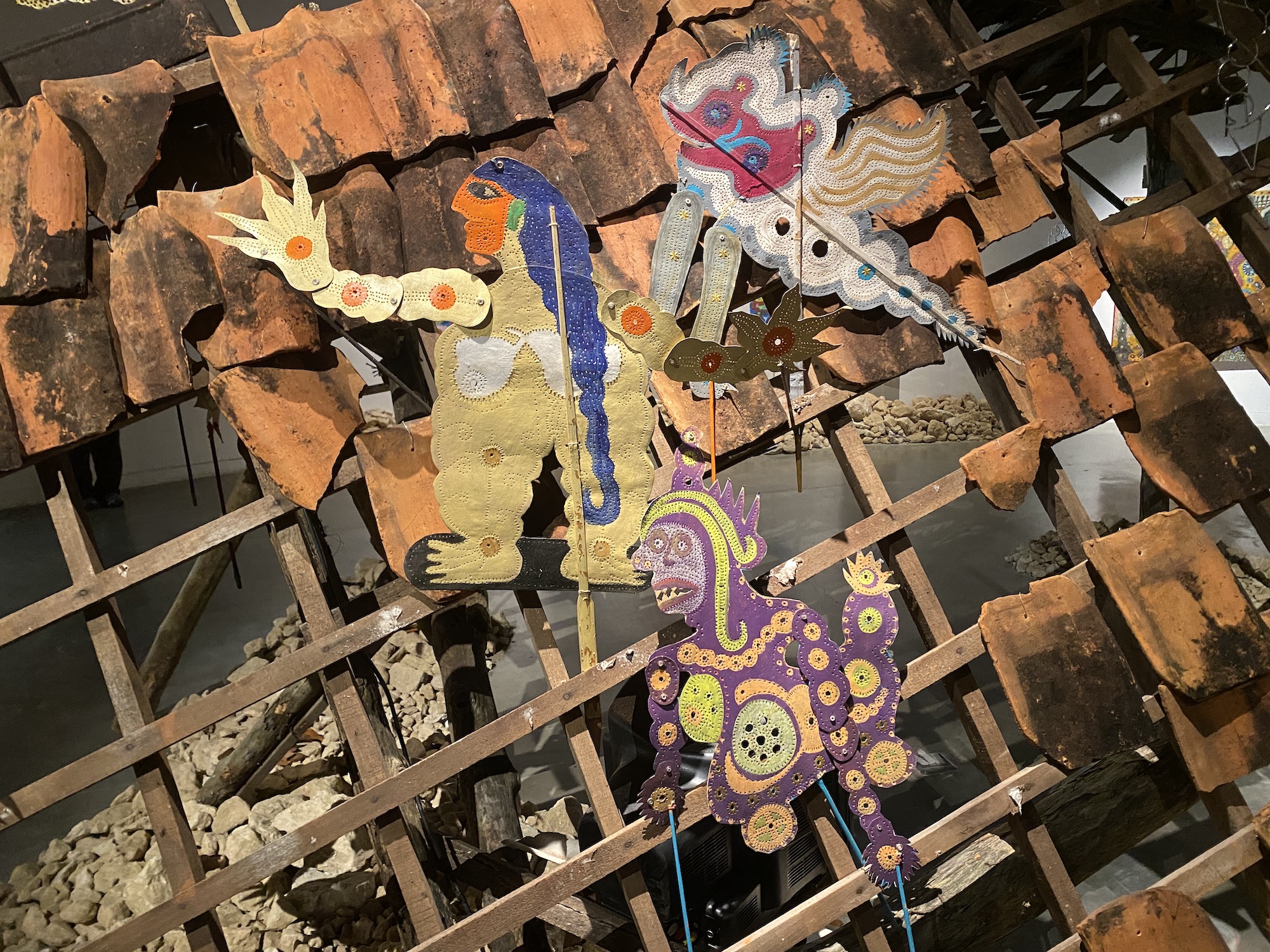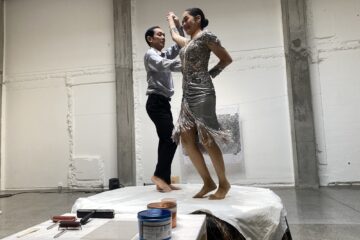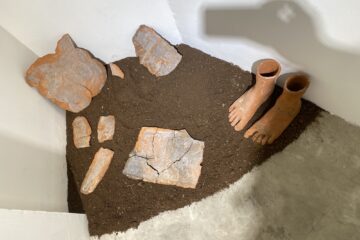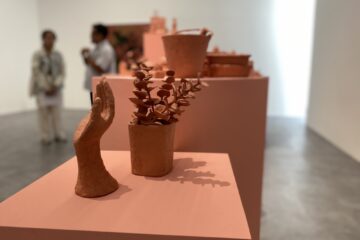The “Staging Desire” exhibition bursts forth as a convergence of two artists with distinct paths: Imam Sucahyo and Nindityo Adipurnomo. Here, performativity is not concealed but embraced as both method and subject.
Unlike conventional art exhibitions that welcome visitors through the front door, “Staging Desire” invites us to enter via the back. From a parking lot, a warehouse door swings open. After climbing a small staircase, we arrive in a liminal space—a storage area for exhibition materials transformed into an initial gateway. The backroom of Salihara Gallery immediately captivates with its theatrical lighting. Carefully arranged spotlights cast moving shadows on the walls, turning a utilitarian corner into a small stage whispering its own story.
At the center of this space, a chaotic pile of straw evokes a rustic, weathered ambiance. Rising boldly from its midst is a wooden staff adorned with a decorative object resembling a bird or butterfly. Its vibrant blue, yellow, and red hues, accented with delicate feathers, breathe life into the rigid straw. To the right, a simple wooden table stands elegantly amid the straw, reinforcing the rustic narrative. In the background, small suspended installations reflect magical silhouettes on the walls when struck by light. A faint shimmer from glass surfaces on the left completes the interplay of visual textures.
This room serves as a captivating prologue: a blend of straw, wood, and theatrical lighting creates an intimate yet enigmatic atmosphere. Ahead, a woven rattan partition acts as a “door” to the main gallery. Sturdy yet flexible, it holds a surprise: when pushed on the right, the woven structure rotates smoothly on its axis. The lively motion of the rattan seems to beckon us into a new world. As I pass through this dynamic portal, I continue to ponder the meaning behind each visual cue. After all, this is an art exhibition—every visual detail is intentional.
Before I can fully process the prologue, the main gallery of Salihara seizes my attention, overshadowing the smaller space. The main room of “Staging Desire” radiates a more compelling theatrical aura, with lighting as its invisible director. Sharp beams carve dramatic contrasts between light and shadow. The illumination doesn’t merely highlight the artworks; it animates dancing silhouettes on the walls, transforming the space into a living, multidimensional stage.
At the heart of the room stands a dilapidated house, a magnetic focal point. Discovered by Imam Sucahyo in a Tuban farm, this weathered structure leans crookedly, whispering tales of a fractured household. Surrounding it are peculiar figures in bold blue, yellow, and red, mounted on wooden staffs. Their expressive faces, set against the rough texture of straw and haphazard folds, form characters within a larger narrative.
Above the house, a vertical structure resembling a fantastical creature looms with “horns” or tentacles at its peak. Its woven wire frame twists, creating an illusion of movement. Its shadow projects grandly onto a circular screen behind, evoking a contemporary wayang (shadow puppet) performance. Nearby, a glowing wooden frame juxtaposes a small television, subtly introducing modernity. This decaying house serves as a convergence point for the two artists’ memories. From this metaphor of weathered wood, the entire exhibition unfolds.
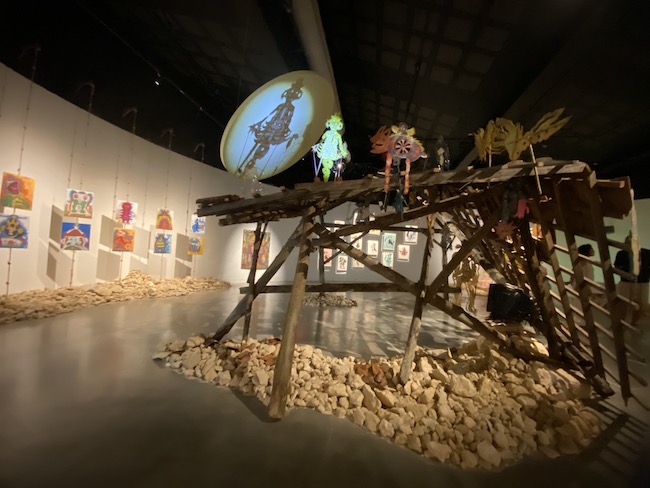
According to curator Zarani Risjad’s notes, “Staging Desire” emerges as a meeting of two artists with divergent approaches. For Imam Sucahyo, creating art is a ritual of embracing observation, memory, and imagination—a fluid fusion of reality. His practice is rooted in Tuban, an ancient port city bearing traces of the Majapahit empire alongside scars of coastal erosion and waste. For Imam, observation transcends mere seeing; it is a process of feeling through intuition and stillness. This openness shapes his perspective.
His cardboard wayang rejects traditional archetypes, leaving narratives open to interpretation and reinterpretation. This ambiguity is its strength, inviting personal projections and ever-shifting readings. For Imam, desire is not a puzzle to solve but a way to engage with the everyday: observing, responding, creating. His work is calm, elusive, and unburdened by the need for resolution—a space where meaning grows alongside the viewer, a desire to evoke lived experiences without constraining their interpretation.
Nindityo Adipurnomo takes a different path. For him, desire is a tool for shaping the subject. Over three decades, his practice has centered on critical reflections about fluid identity. Here, Lacan’s theory of desire finds relevance: desire rooted in absence, manifested as performance. In this framework, subjectivity is not a stable core but a construct of images, language, and longing for something perpetually out of reach.
Here, Lacan’s theory of desire finds relevance: desire rooted in absence, manifested as performance.
The exhibition’s structure mirrors this concept. The choice of entering through the gallery’s back door is no coincidence—it is a liminal zone, a backstage where transformation begins. This spatial choreography reinforces the theatricality of “Staging Desire,” where identity is constructed through the viewer’s gaze. As Lacan suggests, desire is not personal but a stage that perpetually unfolds. Here, performativity is not hidden but becomes both method and subject. The back door we pass through is key: it reminds us that every identity is an act born in darkness.
Two Interpretations of Ruins
For Imam, the dilapidated house is a crumbling shelter of the soul. As its wood decays, its energy scatters freely, no longer contained. The ruins reflect fractured domestic structures, eroded shared values, and shattered social cohesion. He recalls it as gubug penceng, the Javanese term for the Southern Cross constellation (Lintang Gubug Penceng). In his childhood, he climbed the slanted roof of his home to study the stars. Now, the similar tilt of this ruined house evokes memories: past stargazing merges with the reality of the fields before him.
Lintang Gubug Penceng—a marker of the southern direction and dry season since the Mataram era—is more than navigation for Imam. Through this ruined house, he articulates a poetic dialogue with the land: how landscapes are understood across generations, then transformed. As climate becomes unpredictable and constellations lose practical function, Imam sees not loss but humanity’s enduring adaptation.
Under the gallery’s spotlight, I no longer view the ruins with the same meaning. I’ve never seen this house in its original context, only as it appears here, and I cannot grasp it as a shelter that no longer protects, as Imam does. To me, it’s a stage: Imam’s cardboard wayang with their strange figures become its new inhabitants, animating a contemporary shadow play. I believe Imam would approve of this interpretation—after all, for him, meaning is always fluid.
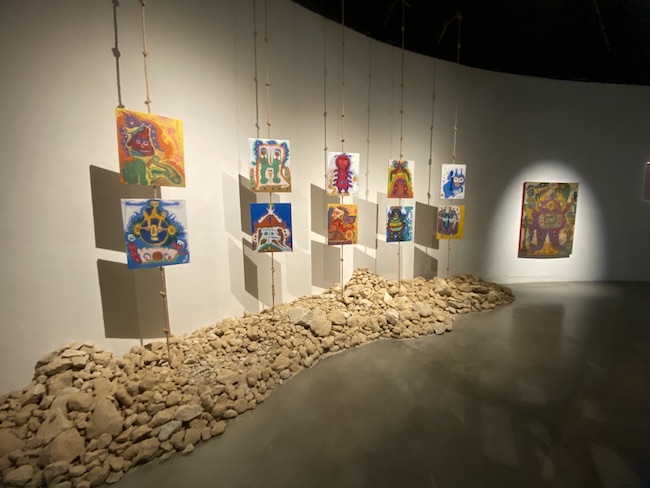
Consider some of these “strange figures.” At one corner of the house stands the most prominent and commanding wayang figure. Its large body is adorned with intricate, colorful ornaments. Its head is crowned with a headdress resembling flames or a radiant sun in yellow, red, and green, exuding grandeur and strength. The figure’s face is painted with a fierce expression: bulging eyes, thick brows, and an open mouth revealing sharp teeth, as if roaring or expressing rage.
Yellow dominates its face, accented with red and blue—colors often symbolizing courage, strength, and spirit in Javanese culture. Its body is covered in dynamic circular and spiral patterns in blue, red, yellow, and green, creating a lively impression. Seated with legs spread, it exudes dominance, holding a staff or weapon in its right hand, symbolizing power or protection.
This figure likely represents a mythological or divine character, such as Rahwana or Batara Kala, often depicted as charismatic yet antagonistic in wayang traditions. The use of vibrant colors and modern patterns suggests it transcends traditional narratives, embodying diversity and creativity in contemporary art. It faintly recalls the wayang figures of Heri Dono.
Beside it stands a smaller figure resembling a bird or mythical creature with a long, sharp beak. Colored in dark brown with white and yellow accents on its beak, its body is adorned with patterns resembling scales or feathers. It appears to hover or fly, with small wings on its sides.
Below, a tiny figure shaped like a fish or miniature dragon in blue and yellow boasts large eyes and a playful expression, its open mouth suggesting speech or song. Its body is dotted with small circles, exuding cheerfulness. In Javanese culture, fish or dragons often symbolize water, fertility, and life. This figure may represent a softer, hopeful aspect of existence, harmonizing with nature and contrasting the dominant figure’s intensity.
Imam seems fond of crafting such figures. In a large painting near the entrance, a vibrant composition brims with abstract elements. At its center stands a primary figure, possibly a mythological or spiritual being, designed in a fantastical style. Its elongated, flexible body is adorned with circular and spiral patterns in bright blue, green, yellow, and pink. The figure’s head features large, expressive eyes gazing at the viewer, creating a mysterious aura.
Its body is decorated with organic elements like dangling leaves and curling tentacles, evoking life and movement. Two yellow circles on its chest, possibly symbolizing eyes or life, are surrounded by web-like or scaly patterns. Its sturdy legs, painted bright yellow with tiny dots, add unique texture.
Surrounding the main figure are complementary elements enhancing the work’s complexity. At the top left, an additional face resembling a mask is encircled by colorful rings, perhaps symbolizing the sun or stars. On the right, a small green figure with a round head stands as if guarding the main figure. The background teems with overlapping geometric and organic patterns, evoking an otherworldly realm brimming with life and energy.
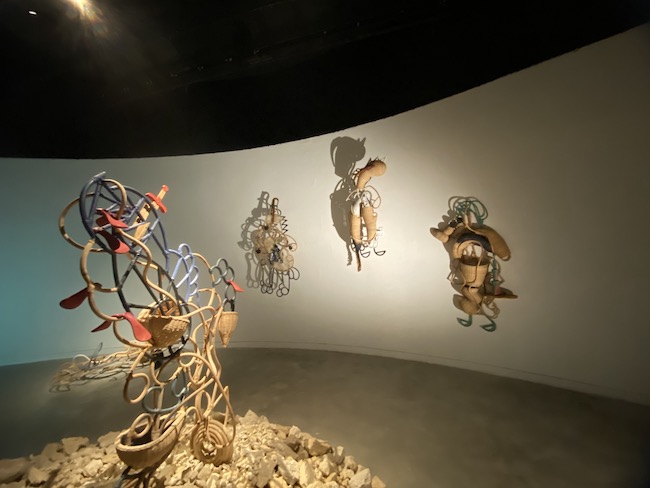
Returning to the “ruined house,” Nindityo interprets it differently from Imam: for him, it’s a metaphor for the erosion of social spaces, particularly the family institution. Like me, he never saw the house in its original context, so his reading stems from absence. In Lacanian terms, desire arises from emptiness, and this broken house becomes a site for projecting narratives of unfulfilled cohesion.
This projection extends to his series Dynasty Family displayed nearby. Titles like Father Surrounded by Sycophants and Father Pitting Against Each Other are not mere labels but “leaks of the subconscious,” hinting at Nindityo’s post-2024 election anxieties. His rattan figures, clad in buffalo hide, crocodile skin, or plastic waste, conceal weapons: from Javanese keris to AK-47s with barrels morphing into limp phalluses.
These hybrid forms, like a Father resembling a giant lizard, are visceral collisions of political violence, tradition, and symbolism. Though separate from the ruined house, these sculptures amplify the same sense of “brokenness”: the fragility of shared meaning amid power struggles.
These hybrid forms, like a Father resembling a giant lizard, are visceral collisions of political violence, tradition, and symbolism.
Nindityo’s interpretation of the house reflects contemporary political concerns. His fragmented works signal deeper anxieties about identity and representation under dynastic politics, particularly post-2024 Indonesian elections and the frustrating persistence of power. Without making direct claims, his art suggests a climate of symbolic erosion, where family bonds and institutional authority become currency and casualties of political ambition.
Ultimately, the collaboration between these two artists evolves into a shared exploration: how desire—whether radiant or hidden in shadows—fuels creation. Nindityo’s decades-long conceptual exploration of identity finds new vitality in Imam’s cardboard wayang. Meanwhile, Imam’s sensory-driven process crystallizes in a stream of longing and imagination.
“Staging Desire” animates desire not as a static theme but as a flowing river, shaping and shaped by its context. Through their respective symbolic worlds, Imam and Nindityo dance at the edge of tension: between self and society, reality and fantasy, longing and fulfillment.
The exhibition offers a space for reflection: when desire becomes a creative engine, new corridors of meaning open. There, amid opposing forces, meanings shift and reveal themselves like wayang shadows dancing on the wall, ever-changing as light touches them.
- Cover image: Hidayat Adhiningrat
- Dancing on the Grave of Severed Memories - September 30, 2025
- The Magic of Objects in Stillness - September 30, 2025
- The Storytelling Soil - September 30, 2025

